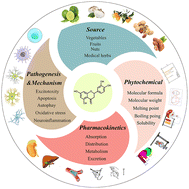Eriodictyol: a review of its pharmacological activities and molecular mechanisms related to ischemic stroke†
Abstract
Ischemic stroke (IS) is characterized by a prominent mortality and disability rate, which has increased the burden on the global economy to a certain extent. Meanwhile, patients benefit little from the limited clinical strategies of intravenous alteplase and thrombectomy due to the limited therapeutic window. Given this, it is urgent to study new therapeutic methods to intervene in these patients. Eriodyctiol (ERD) is a major natural flavonoid, which widely exists in fruits, vegetables, and medicinal herbs, and has various pharmacological properties. It has been reported that ERD can maintain homeostasis in organisms by exerting neuroprotective and vascular protective effects. Therefore, more and more studies have focused on the pharmacological activity and mechanism of ERD in IS. This paper provides an overview of the plant sources, phytochemical properties, pharmacokinetics, and pathogenesis, as well as the pharmacological effects and mechanisms of ERD in IS. To date, preclinical studies on ERD in diverse cell lines and animal models have established the idea of ERD as a feasible agent capable of specifically ameliorating IS. The molecular mechanisms of ERD to prevent or reduce IS are mainly based on the inhibition of inflammation, oxidative stress, autophagy and apoptosis. Nevertheless, the mechanism of ERD against IS is flawed and needs more exploration by the research community. Moreover, well-designed clinical trials are needed to increase the scientific validity of the beneficial effects of ERD against IS.

- This article is part of the themed collection: Food & Function Review Articles 2023


 Please wait while we load your content...
Please wait while we load your content...